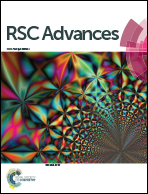Novel synthesis process for solar-light-active porous carbon-doped CuO nanoribbon and its photocatalytic application for the degradation of an organic dye
Abstract
A simple, one-step novel solution process was developed for the synthesis of carbon-doped CuO (C-CuO) nanoribbons without the use of a catalyst, template, substrate, or costly instrumentation at room temperature. The precursor materials used were converted into C-CuO nanoribbons in ethanol (95%) at high concentrations (4.37 mg mL−1) as a colloidal solution with very high dispersion stability. The simplicity, reaction time, production cost, production yield, and environmental friendliness of this process make it suitable for the large-scale industrial production of C-CuO nanoribbons. The prepared nanoribbon is also separable and redispersible in other organic solvents. The dispersibility in multiple solvents highlights its versatility as a platform for depositing other nanomaterials on its surface in organic media to improve its additional properties as a candidate for other applications. Its three-dimensional surface morphology was characterized, which suggested that the prepared C-CuO nanoribbon was highly porous. Free-standing C-CuO nanoribbon films were also prepared using a simple process. The prepared film of porous C-CuO nanoribbon exhibited excellent light absorption ability in the range from visible to near-IR light with higher intensity. The superior light absorption properties of the C-CuO nanoribbons were utilized in a photocatalyst to decompose an organic dye in visible light. The degradation of the organic dye (96.64%), recycling performance (93.94%), number of cycles (24), and degradation time (120 min) highlight its potential as a very good photocatalyst.


 Please wait while we load your content...
Please wait while we load your content...